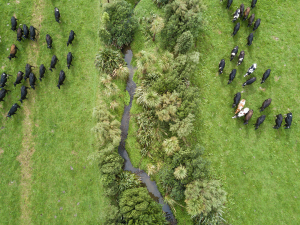Genetics, Efficiency and Performance: How the Burgesses are raising the bar at Te Poi
Bill and Michelle Burgess had an eye-opening realisation when they produced the same with fewer cows.
 Throughout the Selwyn and Hinds programme, different options for reducing N loss were trialled across individual farms, depending on the needs of specific farm systems.
Throughout the Selwyn and Hinds programme, different options for reducing N loss were trialled across individual farms, depending on the needs of specific farm systems.
A DairyNZ programme to help farmers in two Canterbury catchments to reduce N loss has proved highly successful.
The programme involved 40 dairy farmers in the Selwyn and Hinds catchments started five years ago and the data shows that at least one farming couple have already met the target of reducing their N losses by 25%. That’s seven years ahead of the time frame set by government.
Overseer information shows N loss reductions of 29% from the 2017/18 season to 2021/22, and a report just released shows a continued downward trend in mean N loss per hectare from dairy farms across Canterbury – a 27.5% decrease over five years to 2021-22.
The Selwyn and Hinds programme aimed to support dairy farmers in the two catchments to meet Environment Canterbury and central government N loss reduction targets, while optimising profit and resilience. DairyNZ general manager for sustainable dairy, Dr David Burger, says the amount of change in both catchments is encouraging and shows the sector is moving in the right direction.
He says the programme has supported dairy farmers to reduce N losses by implementing solutions that work at a farm level, complementing the positive work already being done by farmers and rural professionals.
“It has also presented good opportunities for dairy farmers to share ideas and work with scientists and sector experts. Farmers have been using the information available to them to implement the best options for their farms,” he says.
Dr Burger says dairy farmers across Canterbury are improving effluent and irrigation management, reducing fertiliser use and increasing their focus on overall efficiency of farm systems, which helps reduce nitrogen being lost into groundwater.
Throughout the Selwyn and Hinds programme, different options for reducing N loss were trialled across individual farms, depending on the needs of specific farm systems.
The results and lessons were shared with other local farmers through field days and events.
Examples of effective options include crops, which are grown to contain excess nitrogen in soils that may otherwise be lost through leaching, and plantain, a low-cost, high-impact mitigation many farmers have incorporated.
The Selwyn and Hinds programme was an extension of previous DairyNZled N loss farm systems research, such as Pastoral 21 and Forage for Reduce N leaching. Many partner farms implemented several of the options identified by this previous research.
A Taranaki farmer and livestock agent who illegally swapped NAIT tags from cows infected with a bovine disease in an attempt to sell the cows has been fined $15,000.
Bill and Michelle Burgess had an eye-opening realisation when they produced the same with fewer cows.
It was love that first led Leah Prankerd to dairying. Decades later, it's her passion for the industry keeping her there, supporting, and inspiring farmers across the region.
Rangitikei Rivers Catchment Collective (RRCC) chairperson Roger Dalrymple says farmers in his region are taking a national lead in water quality awareness and monitoring.
One young couple is proving farm ownership is still within reach for young Kiwis.
Greenlea Premier Meats managing director Anthony (Tony) Egan says receiving the officer of the New Zealand Order of Merit (ONZM) honour has been humbling.
President Donald Trump’s decision to impose tariffs on imports into the US is doing good things for global trade, according…
Seen a giant cheese roll rolling along Southland’s roads?